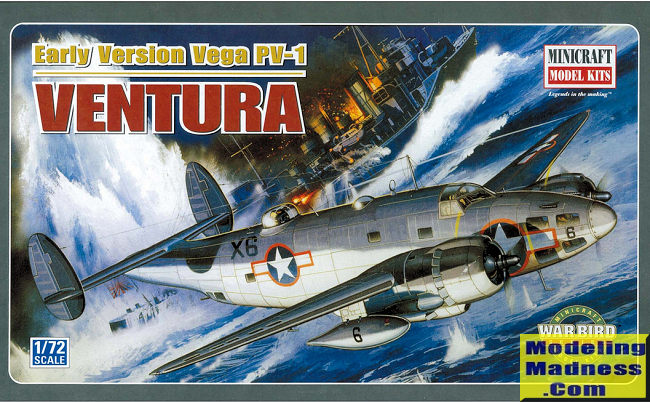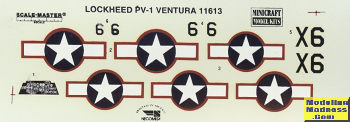
Minicraft 1/72 PV-1 Ventura (early)
| KIT #: | 11638 |
| PRICE: | $11.98 on sale |
| DECALS: | Five options |
| REVIEWER: | Scott Van Aken |
| NOTES: |

| HISTORY |
The PV-1 Ventura, built by the Vega Aircraft Company division of Lockheed (hence the "V" Navy manufacturer's letter that later replaced the "O" for Lockheed), was a version of the Ventura built for the U.S. Navy. The main differences between the PV-1 and the B-34 were the inclusion of special equipment in the PV-1, adapting it to its patrol bombing role. The maximum fuel capacity of the PV-1 was increased from 1,345 gal (5,081 l) to 1,607 gal (6,082 l), to increase its range; the forward defensive armament was also reduced for this reason. The most important addition was of an ASD-1 search radar.
Early production PV-1s still carried a bombardier's station behind the nose radome, with four side windows and a flat bomb-aiming panel underneath the nose. Late production PV-1s dispensed with this bombardier position and replaced it with a pack with three 0.50 inch (12.7 mm) machine guns underneath the nose. These aircraft could also carry eight 5-inch (127 mm) HVAR rockets on launchers underneath the wings.
The PV-1 began to be delivered in December 1942, and entered service in February 1943. The first squadron in combat was VP-135, deployed in the Aleutian Islands in April 1943. They were operated by three other squadrons in this theatre. From the Aleutians, they flew strikes against bases in Paramushiro and Shimushu, Japanese islands (now occupied by the Russians) in the Kurile chain. Often, PV-1s would lead B-24 bomber formations, since they were equipped with radar. In late 1943, some PV-1s were deployed to the Solomon Islands as night fighters with VMF(N)-531, a Marine Corps fighter squadron.
| THE KIT |
![]() A
new kit this is not with a 1997 date on the instructions. However, it is not
difficult to build and also not all that highly detailed. There are the required
engraved panel lines and the clear parts are not only nicely done, but have
reasonably prominent frame lines. There are two bags of airframe sprues, the one
with the wings is pure white and the other one is an off-white plastic.
A
new kit this is not with a 1997 date on the instructions. However, it is not
difficult to build and also not all that highly detailed. There are the required
engraved panel lines and the clear parts are not only nicely done, but have
reasonably prominent frame lines. There are two bags of airframe sprues, the one
with the wings is pure white and the other one is an off-white plastic.
The interior is a floor, rear bulkhead, pair of seats, pair of control wheels and an instrument panel on which a decal is placed. There is a Martin turret which consists of a lower section, the guns and the blister. It appears that one could install this without the clear part when the fuselage halves are closed. The entire nose is clear with a clear lower insert. There are also windows for the fuselage that are inserted from the inside. The bomb bay doors is a separate bit. There is no bomb bay so this is in the closed position. I would also leave off the belly transparency and guns until after painting.
Tailplane is upper and lower halves
onto which the fins are attached. The fin parts have the tailplane extension
pieces  molded in place. The kit's
engines are a rear cylinder bank half with a complete front set of cylinders.
Pushrods are molded in place. The only props provided are the paddle blade
versions. Wings are upper and lower halves that trap the engine assembly.
Nacelles are molded into the wing halves. There are fuel tanks for under the
wings with a section of the pylon molded into the lower wing. You need to cut
open the main gear doors prior to installation. There are also various antennas
and gun barrels to attach.
molded in place. The kit's
engines are a rear cylinder bank half with a complete front set of cylinders.
Pushrods are molded in place. The only props provided are the paddle blade
versions. Wings are upper and lower halves that trap the engine assembly.
Nacelles are molded into the wing halves. There are fuel tanks for under the
wings with a section of the pylon molded into the lower wing. You need to cut
open the main gear doors prior to installation. There are also various antennas
and gun barrels to attach.

| CONCLUSIONS |
Actually, this one builds quite well. While this boxing may no longer be easily found, the basic kit itself is not that difficult to locate. It is a plane that paid an important part in the war, though it was not widely heralded as such.
Let me add a bit of a note. This kit is also boxed as a Ventura II. However, from my understanding that version does not use the paddle-blade props so you need to source those from somewhere else or trim down the kit ones.
| REFERENCES |
https://en.wikipedia.org/wiki/Lockheed_Ventura#PV-1_Ventura
August 2019
Copyright ModelingMadness.com. All rights reserved.
If you would like your product reviewed fairly and fairly quickly, please contact the editor or see other details in the Note to Contributors.
Back to the Main Page Back to the Review Index Page Back to the Previews Index Page